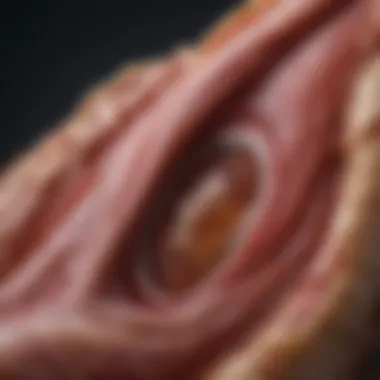Understanding Bladder Stones in Dogs: Causes Explained


Intro
Bladder stones in dogs represent a significant health concern, affecting countless pets each year. These solid formations, known scientifically as uroliths, can cause various health complications and considerable discomfort. Their formation often depends on a confluence of factors including dietary habits, fluid intake, and the dog’s unique genetic predispositions. Understanding the intricate causal relations is essential for pet owners and veterinarians alike. Being well-informed may aid in the prevention and management of this painful condition.
Animal Overview
Common Name and Scientific Classification
The domestic dog, or Canis lupus familiaris, serves as a vital companion to humans. This species showcases remarkable diversity, with various breeds having distinct traits that can influence health outcomes, including susceptibility to bladder stones.
Physical Characteristics
Dogs display a myriad of physical characteristics determined by their breed. Size can range from tiny Chihuahuas to large Great Danes, and even within similar sizes, body conformation varies widely. Such differences can impact urinary system health, potentially leading to stone formation.
Habitat and Distribution
Domestic dogs are globally ubiquitous, living in various environments, from urban apartments to rural farms. This distribution means their diets and lifestyles can vary drastically, affecting hydration levels and nutrient availability, both crucial for bladder health.
Understanding the Causes of Bladder Stones
Diet
The composition of a dog’s diet is one of the most significant contributing factors in the formation of bladder stones. Certain minerals and nutrients, when present in excess, can lead to crystallization in the urine, forming stones. Pet owners must consult their veterinarians to create balanced meal plans that avoid such pitfalls.
Hydration
Adequate hydration is vital. Insufficient water intake can lead to concentrated urine, facilitating stone formation. Dogs that are not encouraged to drink sufficient water or those who primarily consume dry food are often at higher risk for developing bladder stones.
Genetics
Genetics can also play an important role in a dog’s likelihood of developing bladder stones. Breeds like Dalmatians, Miniature Schnauzers, and Bulldogs are genetically predisposed to certain types of stones, making awareness of breed-specific health risks crucial for pet owners.
Underlying Medical Conditions
Various medical issues can predispose dogs to bladder stone formation. Conditions such as urinary tract infections, metabolic disorders, and abnormalities in kidney function can all contribute. Regular veterinary check-ups help identify such underlying conditions early, improving the chances of effective management.
"Preventive care, including periodic veterinary examinations, is key to detecting issues before they lead to severe complications."
Ending
Understanding the factors that lead to bladder stones in dogs is fundamental for effective prevention and treatment. Pet owners should pay close attention to their dog's diet, hydration, and health status to mitigate these risks. Collaboration with a veterinarian is essential for maintaining a dog’s urinary health and ensuring a high quality of life.
Preamble to Bladder Stones in Dogs
Bladder stones in dogs represent a critical area of canine health that merits in-depth investigation. The formation of these stones can lead to substantial discomfort and potential complications if not addressed promptly. Understanding the nuances behind the causes of bladder stones is vital for pet owners and veterinary professionals alike.
Several factors contribute to the development of bladder stones, including dietary choices, hydration levels, and genetic predispositions. Each of these elements intertwines, creating a complex tapestry that influences a dog's health. A comprehensive grasp of these causes aids in the prevention and timely treatment of this condition, ultimately promoting a dog's well-being.
Moreover, bladder stones can indicate underlying health issues, making it imperative to consider other health parameters when addressing this condition. Educating oneself on bladder stones fosters preventative measures that are essential in shielding dogs from future health issues. This knowledge can empower dog owners to make informed decisions concerning their pets' diets, water intake, and overall health management.
From an educational standpoint, exploring this topic helps in disseminating critical information within the veterinary and pet-owning communities. It encourages a proactive approach rather than a reactive one when dealing with bladder stones.
"Informed pet ownership is fundamental to preventing health issues in dogs. Awareness of conditions such as bladder stones empowers owners to act swiftly in consultation with veterinarians."
Definition of Bladder Stones
Bladder stones, medically known as uroliths, are crystalline formations that develop in the urinary bladder. They result from abnormal mineral concentrations in the urine, which can lead to significant health complications for dogs. Understanding the definition and characteristics of bladder stones is crucial for both pet owners and veterinary professionals.
The formation of bladder stones occurs when minerals crystallize and aggregate into solid masses. These stones can vary in size and may have different compositions based on the underlying causes. The most common types include struvite, calcium oxalate, urate, and cystine stones. Each type is associated with specific risk factors and necessitates tailored management strategies.
Importance of Understanding Bladder Stones
Recognizing what bladder stones are is the first step in addressing their formation in dogs. Being aware of how these stones develop, and being able to identify them early, can significantly impact treatment outcomes. Dogs suffering from bladder stones may show symptoms such as straining to urinate, blood in urine, or frequent urination attempts.
Diagnosing bladder stones early leads to quicker treatment, reducing the chances of complications such as urinary obstruction or infection. Therefore, understanding the basic definition of bladder stones informs both prevention and treatment efforts.
Key Considerations
- Composition Matters: Different types of stones can have unique causes and require specific treatment approaches. For example, struvite stones are often linked to urinary tract infections, while calcium oxalate stones can involve dietary factors and metabolic issues.
- Size Variation: The size of bladder stones can vary widely. Some are small enough to pass unnoticed, while others may cause significant pain and risk urinary blockage.
- Treatment Implications: The method of treatment can depend on the type of stone present. Some cases may require surgical intervention, while others might be managed through dietary changes or medications.
Understanding these factors creates a foundation for pet owners to effectively manage their dog's health. The need for consultation with a veterinarian cannot be overstated, as they play a vital role in diagnosis and treatment planning. By grasping the fundamental definitions of bladder stones, stakeholders can better navigate the complexities of canine urinary health and take proactive steps to ensure the wellbeing of their pets.
Types of Bladder Stones
Understanding the types of bladder stones is essential for diagnosing and treating this condition in dogs. Each type has unique characteristics and causes, which can influence management and prevention strategies. Knowledge of these differences can help caregivers and veterinarians make informed decisions on the best course of action for affected dogs.
Struvite Stones
Struvite stones are one of the most common types of bladder stones seen in dogs. These stones typically form in alkaline urine and are often associated with urinary tract infections caused by certain bacteria. The minerals involved in struvite stones include ammonium, phosphate, and magnesium.
The formation of struvite stones is frequently observed in female dogs, especially those predisposed to urinary tract infections. Identification of this type of stone is crucial, as its treatment may involve addressing the infection and altering the diet to promote acidic urine.
Calcium Oxalate Stones
Calcium oxalate stones are another prevalent type of bladder stone in dogs. These stones can develop in both acidic and neutral urine, making their prevention more complex. They are often found in male dogs and can be linked to certain metabolic disorders.
Diet plays a significant role here. High levels of calcium and oxalate in the diet, along with inadequate hydration, can increase the risk of calcium oxalate stones. Surgical intervention may be necessary to remove larger stones, and prevention strategies may include dietary adjustments and increasing water intake.
Urate Stones
Urate stones are less common but represent a significant health concern. These stones typically arise due to the body’s inability to properly metabolize purines, substances found in certain foods. Dogs with genetic predispositions, particularly Dalmatians, are more likely to develop urate stones.
Management of urate stones often involves dietary modifications to reduce purine intake, alongside medications to help dissolve the stones. Regular veterinary check-ups are important for monitoring these dogs’ conditions, as urate stones can lead to urinary obstruction if not treated effectively.
Cystine Stones
Cystine stones are rare and are usually seen in male dogs due to a genetic defect in the renal tubules that leads to excessive cystine in the urine. These stones form in acidic urine, making their presence often difficult to detect until significant symptoms arise.


Treatment approaches for cystine stones mostly involve dietary changes aimed at increasing urine pH, alongside medications that can help reduce cystine levels in the urine. Regular monitoring and follow-up are essential to prevent recurrence, as these stones can form repeatedly due to the underlying genetic predisposition.
The type of bladder stone significantly influences treatment options, underscoring the importance of accurate diagnosis and management strategies.
Primary Causes of Bladder Stones
Bladder stones in dogs are a serious concern. Understanding the primary causes behind this condition is crucial for prevention and treatment. These stones often lead to urinary tract problems and discomfort for the dog. Several factors contribute to their formation, including dietary influences, hydration levels, genetic predisposition, and underlying health issues. Recognizing these causes helps owners take proactive measures to avoid complications.
Dietary Factors
A significant aspect of bladder stone formation lies in diet. What a dog eats can significantly impact urine composition and, consequently, stone development. If the diet contains high levels of certain minerals, it can create an environment conducive to stone formation. Additionally, an imbalanced diet may alter urine pH levels, further contributing to the issue.
Here are key elements linked to diet:
- High Mineral Content: Excess minerals such as magnesium, phosphorus, or calcium can contribute to struvite or calcium oxalate stones.
- pH Levels of Urine: The acidity or alkalinity of urine affects crystal formation. Diet can shift these pH levels, leading to different types of stones.
- Dietary Imbalances: Nutritional deficiencies or excesses can create a more favorable environment for stone formation.
Hydration and Its Role
Hydration is another vital factor. Proper water intake maintains urine dilution, thereby helping prevent crystal and stone formation. A well-hydrated dog has less concentrated urine, which reduces the likelihood of mineral deposit accumulation. Conversely, dehydration can promote the formation of bladder stones due to increased concentration of minerals in the urine.
Importance of Water Intake
Encouraging dogs to drink adequate amounts of water is essential. This can be improved by:
- Providing fresh water at all times
- Adding moist or wet food to their diet
- Offering ice cubes or broth for enhanced hydration
Effects of Dehydration
A dehydrated dog may experience several issues, including:
- Concentrated urine, which promotes stone growth
- Increased risk of urinary tract infections
- General health decline due to impaired function of vital organs
Genetic Predisposition
Certain breeds show higher prevalence in bladder stone formation due to genetic factors. For example, breeds such as Yorkshire Terriers and Miniature Schnauzers are often more susceptible. This genetic tendency can be crucial in predicting vulnerability and tailoring preventive care.
Breed-Specific Risk Factors
Understanding genetic predispositions assists in monitoring and management. It can help owners recognize signs early and maintain a preventive approach to their dog’s health.
Familial Trends in Bladder Stones
There often exists a familial trend where bladder stones occur frequently among related dogs. This genetic link highlights the need for diligent observation and potentially preventive measures within breeds known for such risks.
Underlying Health Conditions
Chronic health issues can also influence the formation of bladder stones. Problems like recurrent urinary tract infections create a breeding ground for stone development. Additionally, metabolic disorders may alter urine composition, aiding calculus formation.
Chronic Urinary Tract Infections
Frequent infections can result in inflamed bladder lining, facilitating stone adherence and growth. Regular veterinary check-ups can help in managing these infections before they lead to more severe complications.
Metabolic Disorders
Several metabolic conditions impact the levels of minerals in the urine, affecting stone formation. Identifying and treating these underlying issues can significantly reduce the risk of bladder stones.
Environmental Influences
Lastly, environmental factors such as climatic variations and living conditions can influence hydration and nutrition, subsequently impacting the risk of stone formation. Dogs in warmer climates may become dehydrated more frequently, increasing the risk of developing stones. Watching how environmental conditions affect your dog's lifestyle can be crucial in prevention.
In summary, recognizing the primary causes behind bladder stones in dogs is essential for effective prevention and treatment. By addressing dietary factors, ensuring adequate hydration, acknowledging genetic predispositions, and managing underlying health conditions, dog owners can actively reduce the risk of this painful issue.
Dietary Factors
Dietary factors play a crucial role in the formation of bladder stones in dogs. Understanding how certain dietary components can contribute to this condition is essential for pet owners seeking to prevent or manage bladder stone issues in their canine companions.
High Mineral Content
The mineral composition of a dog's diet is a significant factor influencing bladder stone formation. Elevated levels of certain minerals, particularly magnesium, phosphorus, and calcium, can lead to the crystallization of urine and subsequently the formation of stones. For example, diets high in these minerals can contribute to the development of struvite stones, which are often seen in dogs with urinary tract infections.
Pet owners should be aware of the mineral content in commercial dog food. Choosing balanced diets that do not excessively load the dog's system with minerals is advisable.
pH Levels of Urine
Urine pH is another dietary factor that can influence bladder stone formation. Dogs with highly alkaline urine are more susceptible to developing struvite stones, while acidic urine is linked to the formation of calcium oxalate stones. A dog's diet can affect urine pH. Diets that are high in carbohydrates or certain animal proteins can raise urine pH, creating an environment conducive to stone formation.
Monitoring the pH of a dog's urine can provide insight into their risk for bladder stones. Regular veterinary check-ups can help assess whether dietary adjustments are necessary to maintain healthier urine pH levels.
Dietary Imbalances
Dietary imbalances, such as improper ratios of certain macronutrients, can also lead to the formation of bladder stones. Dogs that receive an inadequate amount of essential fats or proteins may experience changes in their urinary composition. Imbalanced diets can alter metabolism, leading to conditions that favor stone development.
Feeding dogs a well-rounded diet that includes adequate protein, fats, and carbohydrates is crucial. Pet owners need to consult with veterinarians to determine the most suitable dietary plan for their dogs, especially if they are prone to urinary issues.
"Prevention of bladder stones often begins with proper diet and hydration. A balanced nutrition is key."
Hydration and Its Role
Importance of Water Intake
Water intake is vital for maintaining overall health in dogs, especially when considering bladder stones. Most dogs require a minimum of 20 to 40 milliliters of water for each kilogram of body weight per day, depending on variables such as activity level, size, and age. Water serves many functions, with one primary role being to dilute the urine.
When dogs consume enough water, the urine becomes less concentrated, reducing the risk of mineral crystallization. A consistent water supply helps keep the urinary system clear and functioning well. In addition to protecting against bladder stones, proper hydration supports kidney function and can also prevent more extensive health issues.
Adapting dietary habits is essential to encourage more water consumption. Wet dog food, for example, has higher moisture content compared to dry kibble. By including wet food in their diet, dog owners may notice improved hydration levels in their pets. Moreover, providing fresh water multiple times a day in clean bowls can encourage drinking.
Effects of Dehydration


Dehydration can have serious repercussions on a dog's health, particularly concerning bladder stone formation. When a dog becomes dehydrated, the urine becomes concentrated. This concentrated urine presents a much higher risk for the formation of crystals and, eventually, stones. Dehydration can result from various factors like high temperatures, limited access to water, or illness.
Some common signs of dehydration in dogs include:
- Dry or sticky gums
- Loss of elasticity in the skin
- Lethargy or reduced energy
- Decreased urination or dark-colored urine
It is vital to recognize these signs early on. Preventing dehydration not only reduces the chances of bladder stones but also safeguards the dog's general health. The owner should ensure their dog has constant access to clean water and monitor their intake, especially during warmer months or after exercise.
Consistent hydration is not only a protective measure against bladder stones but also a fundamental aspect of a dog’s overall health.
For further insights on pet care, refer to Wikipedia and Britannica.
Genetic Predisposition
Genetic predisposition plays a significant role in the development of bladder stones in dogs. Understanding the hereditary factors associated with this condition is crucial for identifying at-risk breeds and for devising effective prevention and treatment strategies. Some dogs may inherit a tendency to form stones due to specific genetic markers, which can affect their metabolism and urinary health. This knowledge allows veterinarians and dog owners to take proactive measures, such as regular screenings and tailored dietary plans, to mitigate the risks.
Breed-Specific Risk Factors
Certain dog breeds are known to be more susceptible to bladder stones than others. For example, breeds like Miniature Schnauzers, Yorkshire Terriers, and Dachshunds show a higher incidence of these urinary issues. This risk often correlates with the metabolism and physiology of these breeds.
- Miniature Schnauzers and Yorkshire Terriers: These breeds tend to develop struvite stones more frequently. The high mineral content in their diets can contribute to this condition.
- Dachshunds: Often associated with calcium oxalate stones, this breed may have a genetic tendency that affects how they process calcium.
It is important to consider these breed-specific factors when evaluating a dog's health. Regular veterinary check-ups can help in early detection, allowing for timely intervention.
Familial Trends in Bladder Stones
Familial trends indicate that if a dog in a family has bladder stones, the likelihood of another family member developing the same condition increases. This suggests a strong genetic influence. Research shows that certain lineages may carry genetic mutations that impact the formation of stones.
"Understanding familial trends can aid in preventative strategies and influence breeding decisions."
- Increased Risk Among Relatives: Owners should be aware of any history of bladder stones within the lineage of their pets.
- Potential for Screening: Genetic tests may become available in the future, which could help owners determine if their pets are at a heightened risk based on inherited traits.
Owners should pay attention to any symptoms and consult with veterinarians regarding family history. Being informed can lead to better health outcomes for future generations of pets.
Underlying Health Conditions
A number of underlying health conditions can contribute significantly to the development of bladder stones in dogs. Understanding these conditions is essential for effective prevention and treatment of this troubling issue. When dogs suffer from chronic diseases or other medical issues, their metabolic processes may be affected in ways that lead to increased risk of stone formation. This relationship underscores the importance of holistic veterinary care and monitoring.
Chronic Urinary Tract Infections
Chronic urinary tract infections (UTIs) are among the primary conditions associated with bladder stones. Infections can alter the chemical environment within the bladder, affecting the balance of nutrients and minerals. When bacteria proliferate, they can lead to the accumulation of certain minerals such as struvite, eventually forming stones.
Dogs with recurring UTIs need careful management. Symptoms such as frequent urination or straining can be indicative of an ongoing issue. Regular veterinary visits are crucial for these dogs, as untreated infections can worsen and lead to further complications.
- Symptoms of UTIs:
- Frequent urination
- Blood in urine
- Pain or discomfort while urinating
Veterinarians typically perform urinalysis and cultures to identify pathogens and prescribe appropriate antibiotics. Ensuring the complete resolution of infections can significantly lower the risk of stone formation, thus highlighting the importance of vigilance and prompt treatment.
Metabolic Disorders
Metabolic disorders can predispose a dog to bladder stones, as these conditions affect how minerals and nutrients are processed in the body. For instance, disorders like hypercalcemia—characterized by elevated calcium levels—can cause calcium oxalate stones to form.
Common metabolic disorders include:
- Cushing's Disease (Hyperadrenocorticism): This condition can lead to increased thirst and urination, promoting crystal formation in the urine.
- Liver disease: Affecting how substances are metabolized, liver dysfunction can alter urine composition, resulting in stones.
- Diabetes Mellitus: The imbalance of glucose levels can lead to changes in urine chemistry, further contributing to the likelihood of stone development.
The management of these conditions often requires a multifaceted approach involving diet, medication, and sometimes lifestyle changes. Monitoring for signs of urinary difficulties remains key. Understanding the link between metabolic disorders and bladder stones provides additional insight into preventive strategies. Regular blood work and careful observation can help in early detection of potential issues, reducing the risk associated with these conditions.
It is essential for dog owners to be aware of any signs of underlying health problems and seek veterinary guidance promptly for their pets' well-being.
Understanding the link between underlying health conditions and bladder stones is crucial. Regular check-ups and open communication with your veterinarian can make a notable difference. This approach will help in not only treating existing issues but also preventing future occurrences of bladder stones.
Environmental Influences
The environmental factors that surround dogs can play a crucial role in the formation of bladder stones. Various elements come into play, each influencing a dog's health and well-being. Addressing these influences will provide a deeper understanding of how external factors may contribute to this condition and underscore the importance of monitoring a dog's environment for signs of distress or illness.
Climatic Variations
Climate has a direct impact on a dog’s hydration levels and dietary habits. In hotter climates, dogs may require increased water intake to maintain proper hydration. Insufficient water can lead to concentrated urine, a factor that often contributes to the formation of bladder stones. Cooler climates present their own challenges. In these conditions, dogs may drink less water than needed, which can have a similar effect. Therefore, owners must be mindful of adding moisture to their dog's diet or encouraging higher water consumption through various strategies. Some suggestions include providing fresh water regularly, using water bowls that attract attention, or adding water to dry food.
According to studies, temperature extremes can influence behavior. During hot weather, dogs tend to become lethargic, which can decrease their desire to drink. This can result in concentrated urine, heightening the risk for stone development. Conversely, during cold months, owners might observe that dogs drink less due to the chilliness of water. Thus, understanding the climate is fundamental in preventing bladder stones.
"Monitoring a dog's water intake based on environmental conditions is essential to fight off potential health issues, including bladder stones."
Living Conditions
The living environment of a dog also plays a significant role in health outcomes. Dogs that live in overcrowded areas or environments lacking proper sanitation may be at increased risk for urinary tract infections. Such infections contribute to the formation of bladder stones. Cleanliness is crucial, as is providing adequate space for a dog to roam and exercise.
Furthermore, the type of flooring in the living area can influence a dog’s behavior and health. Hard surfaces may lead to injuries or strains, inhibiting a dog's desire to move and explore, which can lead to reduced exercise and hydration. Inadequate living conditions can also impact mental stimulation, leading to stress. Stressed dogs may not focus on their hydration or diet needs, which can further contribute to health risks like bladder stones.
In summary, monitoring a dog's living conditions and climate is essential for managing any risk associated with bladder stones. Attention to the physical environment and appropriate living space can significantly affect a dog’s overall health and help mitigate potential issues, including the formation of bladder stones.
Signs and Symptoms of Bladder Stones
Recognizing the signs and symptoms of bladder stones in dogs is essential for early diagnosis and treatment. Bladder stones can cause significant discomfort for dogs and may lead to more serious health complications if not addressed promptly. By understanding these symptoms, pet owners and veterinarians can work together to ensure the well-being of affected dogs.
Common Signs to Watch For
- Frequent Urination: Dogs may exhibit a need to urinate more often than usual. They may go outside and attempt to urinate multiple times but produce only small amounts of urine each time.
- Straining to Urinate: You may notice your dog straining or showing signs of discomfort while trying to urinate. This can be due to blockages caused by stones.
- Blood in Urine: Hematuria, or the presence of blood in the urine, is a serious symptom indicating potential damage to the urinary tract.
- Painful Urination: Dogs may vocalize, whine, or show agitation while urinating, indicating pain associated with bladder stones.
- Licking the Genital Area: Excessive licking or grooming of the genital region might be observed, as dogs try to relieve the discomfort they experience.
- Inappetence: A decrease in appetite can occur as the dog feels unwell due to the underlying health concerns caused by bladder stones.
- Vomiting: This is less common but can occur in severe cases, as distress from the bladder stones affects the overall health of the dog.
The Importance of Diagnosis
Diagnosing bladder stones relies heavily on observing these symptoms. Early intervention can prevent further complications, such as urinary tract infections or even bladder rupture in extreme cases. If any of these signs are present, it is crucial to consult a veterinarian.
"Prompt recognition of symptoms can mean the difference between a simple treatment and a complicated surgical procedure."


Closure
Diagnosis of Bladder Stones
Diagnosing bladder stones in dogs is essential for effective treatment and management. Early detection can significantly reduce complications and improve a dog's quality of life. Understanding how to diagnose this condition involves knowledge of various examination methods and tests that aid veterinarians in confirming the presence of stones.
A thorough diagnosis involves multiple steps, starting from clinical evaluation to more specialized testing techniques. Each aspect is not just crucial but forms a continuum that can either lead to a simple solution or a more complex treatment plan.
Veterinary Examination
The veterinary examination is the first point of contact for determining whether a dog has bladder stones. This examination typically includes a detailed medical history and a physical assessment. Veterinarians will often look for signs such as difficulty urinating, blood in urine, or frequent attempts to urinate without success.
Physical exams may reveal a distended bladder, pain during palpation, or even signs of discomfort when the abdomen is touched.
In addition, a thorough review of the dog's diet and hydration habits can provide insights into potential causes of stone formation. Therefore, pets suffering from discomfort should see their vet swiftly.
Imaging Techniques
Once a physical examination suggests the possibility of bladder stones, imaging techniques become necessary for a concrete diagnosis. Commonly used methods include X-rays and ultrasounds.
- X-rays can provide a visual representation of the stones, especially if they are mineral-based and thus have higher radiopacity.
- Ultrasound, on the other hand, allows for a more detailed view of the bladder and can identify stones that are not visible on X-rays.
Both imaging techniques have their purposes and can be vital to determining the size and location of the stones. These tools inform the veterinarian regarding the best course of action moving forward.
Urinalysis
Urinalysis is another critical component in diagnosing bladder stones. It provides valuable information regarding the constituents of the dog's urine. Through urinalysis, clinicians can check for abnormal pH levels, crystal formation, and the presence of bacteria or red blood cells.
The urinalysis results can help pinpoint the type of stones and guide treatment plans effectively. When done correctly, this can illuminate underlying health problems or urinary tract infections that may have contributed to stone formation.
In summary, rigorous diagnostic efforts focusing on veterinary examinations, imaging techniques, and urinalysis create a comprehensive framework for identifying bladder stones. This approach not only confirms the presence of stones but also aids in preparing an effective treatment regimen.
Treatment Options for Bladder Stones
Treatment for bladder stones in dogs requires careful consideration of several factors. Understanding the available options is essential for effective management of this condition. Treatment can vary based on the type of stones present, their size, location, and the overall health of the dog. Addressing bladder stones promptly can prevent serious complications such as urinary blockage, infections, or even kidney damage.
Veterinarians typically recommend a combination of surgical intervention and medical management as treatment options. Each of these has specific benefits and considerations that must be evaluated on a case-by-case basis.
Surgical Intervention
Surgical intervention is often performed when bladder stones are large or cause significant obstruction. The primary aim is to remove the stones completely, providing immediate relief from pain and discomfort. The surgical procedure mainly involves cystotomy, where a surgeon opens the bladder to extract the stones.
Benefits of surgical intervention include:
- Immediate resolution: Stones can be removed in one procedure, alleviating symptoms quickly.
- Diagnosis confirmation: During surgery, the veterinarian can also inspect the bladder for other potential issues, providing a more complete assessment.
- Prevent recurrence: If the full type and size of stones are known, preventive measures can be taken more effectively.
However, considerations must also be made:
- Anesthesia risks: As with any surgery, there are risks associated with anesthesia.
- Recovery time: Post-operative recovery requires monitoring and care, which can be a commitment for the owner.
- Potential for stone recurrence: Though surgery removes existing stones, it does not prevent future stone formation if underlying causes are not addressed.
Medical Management
For smaller stones, or if the dog is not a candidate for surgery, medical management can be effective. This approach often includes dietary changes, medications, and increased water intake. Medical management focuses on breaking down the stones and preventing new ones from forming.
Some key techniques used in medical management include:
- Specialized diets: Formulated diets can alter the urinary pH and reduce stone formation. Foods that dissolve struvite stones are available, while high-fiber diets can benefit dogs with calcium oxalate stones.
- Medications: Certain medications can help control urinary tract infections or alter the body’s mineral balance. These can reduce the risk of stone formation significantly.
- Hydration encouragement: Ensuring that dogs consume enough water is pivotal. Increased water intake dilutes the urine, reducing the concentration of minerals that can form stones.
A notable point is that medical management often requires ongoing commitment and monitoring. Regular veterinary visits are essential to ensure the treatment is effective, adjusting as needed for the dog's response.
"Proactive management is key to reducing the risk of bladder stones reoccurring. Owners must remain vigilant regarding their dog's health and dietary needs."
In summary, both surgical and medical options have distinct benefits and considerations in treating bladder stones in dogs. Pet owners should consult with their veterinarian to determine the best course of action tailored to their dog's specific needs. Understanding these treatment options will aid in managing this common yet treatable condition.
Preventive Measures
Preventive measures are crucial in managing and reducing the risk of bladder stones in dogs. Understanding how to maintain the health of your dog’s urinary system not only alleviates potential discomfort but also avoids more serious complications. Implementing effective strategies requires thoughtful consideration of various factors including diet, hydration, and routine care. These preventive steps can lead to a better quality of life for dogs, promoting longevity and minimizing the occurrence of painful conditions.
Dietary Adjustments
Dietary adjustments serve as a fundamental building block in preventing bladder stones. High-quality dog food plays an essential role in influencing the composition of urine. Foods rich in certain minerals can contribute to stone formation, motivating owners to reconsider their dog's diet.
- Ensure that the dog’s diet is formulated to control mineral levels, particularly calcium and phosphorus.
- Choose foods lower in purines to reduce urate stone risk.
- Consult with a veterinary nutritionist when making significant changes to the diet, as they can provide a diet tailored to the dog's specific needs.
Balancing nutrients and avoiding excessive supplementation of minerals are important aspects of dietary management. Also, limiting the intake of treats high in sodium can further support healthy urinary function.
Encouraging Hydration
Hydration is essential for the health of any dog, but it is especially critical in preventing bladder stones. Water intake dilutes urine, decreasing the concentration of stone-forming substances. Owners should take active steps to encourage their dogs to drink more water.
- Offer fresh, clean water at all times, changing it regularly to keep it appealing.
- Consider adding water or broth to dry food to increase overall fluid intake.
- Provide a water fountain, as many dogs prefer running water and may drink more enthusiastically from it.
Encouraging regular bathroom breaks can also help flush the urinary system, reducing the likelihood of crystal formation.
Routine Veterinary Check-ups
Routine veterinary check-ups are an essential preventive measure that should not be overlooked. Regular visits allow for early detection of potential health issues related to urinary health, including bladder stones.
- Schedule annual or bi-annual check-ups based on the dog’s age and health status. During these visits, veterinarians can perform urinalysis and other necessary tests to evaluate urinary composition.
- Vaccinations and parasite control are also vital aspects of health management, contributing to the overall well-being of the dog.
- Discuss any behavioral or physical changes observed in the dog during the visit, as these can be indicative of underlying conditions.
Regular veterinary care can detect issues before they become serious, aiding in the effective prevention of bladder stones and other health complications.
Through thoughtful dietary choices, encouragement of adequate water intake, and routine veterinary visits, owners can significantly reduce the risk of bladder stones in their dogs. These proactive measures not only promote overall health but foster a closer bond between the dog and owner by ensuring the dog’s comfort and well-being.
Ending
In the final analysis of bladder stones in dogs, understanding their causes is fundamental for effective prevention and treatment. Bladder stones can lead to distressing health issues if not addressed promptly. This article articulated various contributors to the condition, encompassing diet, hydration, genetics, and underlying health conditions. Each of these elements plays a crucial role in the formation of bladder stones.
The insights gained from this exploration allow pet owners and veterinarians alike to recognize the symptoms early and take appropriate action. Identifying the dietary factors, ensuring adequate hydration, and being aware of breed predispositions are key advantages that can mitigate the risks associated with bladder stones. Furthermore, awareness of health conditions, such as chronic urinary tract infections, can inform proactive measures in a dog's healthcare routine.
The significance of regular veterinary check-ups cannot be overstated. Routine examinations can uncover potential issues before they escalate, reinforcing the importance of preventive care. This approach fosters a proactive rather than reactive stance toward canine health.
Moreover, while treatment options exist, the focus should ideally center on prevention. By integrating the findings from this article into practical pet care strategies, owners can contribute positively to their dog's overall well-being. The collaborative efforts between pet owners and veterinarians are pivotal in managing bladder stones and ensuring the long-term health of dogs.







